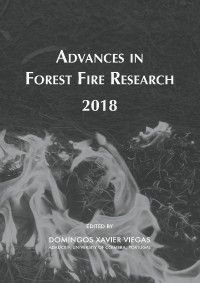Please use this identifier to cite or link to this item:
https://hdl.handle.net/10316.2/44582| DC Field | Value | Language |
|---|---|---|
| dc.contributor.author | Athanasiou, Miltiadis | |
| dc.contributor.author | Xanthopoulos, Gavriil | |
| dc.date.accessioned | 2018-11-09T14:10:23Z | |
| dc.date.accessioned | 2020-09-06T17:31:30Z | - |
| dc.date.available | 2018-11-09T14:10:23Z | |
| dc.date.available | 2020-09-06T17:31:30Z | - |
| dc.date.issued | 2018 | - |
| dc.identifier.isbn | 978-989-26-16-506 (PDF) | |
| dc.identifier.uri | https://hdl.handle.net/10316.2/44582 | - |
| dc.description.abstract | This paper presents a study on the phenomenon of spotting in some of the most common forest vegetation types in Greece, during wildfires in the 2007-2017 period. Monitoring and documenting selected wildfires during this period, noting the appearance or absence of spot fires and the prevailing conditions at the time, a database of 166 field observations was developed. The database includes information on the number of observed spot fires (Nκ), the in situ measured relative humidity (RH, %) values, the wind speed, the forest fuel type where the firebrands had landed, namely maquis, phrygana and grasses, the maximum spotting distance (Dκ, m) from the fire perimeter, the fire perimeter segment (head or flank) where the firebrands came from, and the fire type, namely surface, passive crown, active crown and plume dominated fire. The database was analyzed first by examining the correlation of RH values with Nκ for the three fuel types. An ordinal variable named Κκ was created in order to represent the following four empirical classes: a) no spotting (Nκ=0, Κκ=0), b) rare spotting (Nκ<3, Κκ=1), c) limited spotting (3 ≤ Νκ ≤ 9, Κκ=2) and d) profuse/massive spotting (Νκ ≥ 10, Κκ=3). At RH values higher than 46%, no spotting ignition was recorded. Massive spotting that triggered extreme fire behavior, was documented for RH values lower than 17%. The RH thresholds for spotting occurrence that were identified for the three forest fuel types on which the firebrands landed, are presented and discussed. The Dκ and the Nκ were correlated with both the fire type and the fire segment on which they were observed. Their descriptive statistics are also presented and discussed. The study confirmed the great spotting potential of the plume dominated wildfires, both in regard to spotting distance and the number of spot fires. | eng |
| dc.language.iso | eng | - |
| dc.publisher | Imprensa da Universidade de Coimbra | por |
| dc.relation.ispartof | http://hdl.handle.net/10316.2/44517 | por |
| dc.rights | open access | - |
| dc.subject | Spotting | eng |
| dc.subject | Spot fire | eng |
| dc.subject | Forest fire | eng |
| dc.subject | Wildfire behaviour | eng |
| dc.subject | Firefighting | eng |
| dc.subject | Greece | eng |
| dc.title | Observations on wildfire spotting occurrence and characteristics in Greece | por |
| dc.type | bookPart | por |
| uc.publication.firstPage | 588 | - |
| uc.publication.lastPage | 597 | - |
| uc.publication.location | Coimbra | por |
| dc.identifier.doi | 10.14195/978-989-26-16-506_65 | - |
| uc.publication.section | Chapter 3 - Fire Management | por |
| uc.publication.digCollection | PB | por |
| uc.publication.orderno | 65 | - |
| uc.publication.area | Ciências da Engenharia e Tecnologias | por |
| uc.publication.bookTitle | Advances in forest fire research 2018 | - |
| uc.publication.manifest | https://dl.uc.pt/json/iiif/10316.2/44582/204211/manifest?manifest=/json/iiif/10316.2/44582/204211/manifest | - |
| uc.publication.thumbnail | https://dl.uc.pt/retrieve/11058817 | - |
| uc.publication.parentItemId | 55072 | - |
| uc.itemId | 68847 | - |
| item.fulltext | With Fulltext | - |
| item.grantfulltext | open | - |
| Appears in Collections: | Advances in forest fire research 2018 | |
Files in This Item:
| File | Description | Size | Format | |
|---|---|---|---|---|
| observations_on_wildfire_spotting_occurrence.pdf | 885.72 kB | Adobe PDF |  |
Items in DSpace are protected by copyright, with all rights reserved, unless otherwise indicated.
